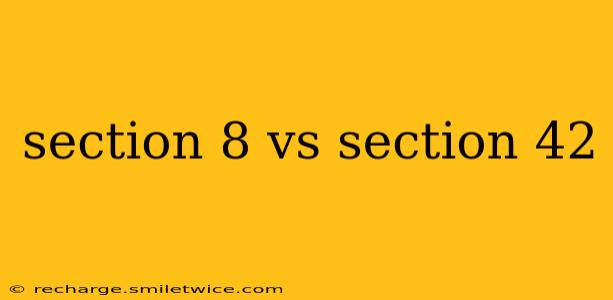The terms "Section 8" and "Section 42" often come up in conversations about affordable housing, but many people aren't entirely clear on their distinctions. Both programs aim to provide affordable housing options, but they differ significantly in their structure, funding, and eligibility requirements. This article will clarify the key differences between Section 8 and Section 42 housing.
What is Section 8 Housing?
Section 8, officially known as the Housing Choice Voucher Program (HCVP), is a federally funded program administered by the Department of Housing and Urban Development (HUD). It provides rental assistance to low-income families, the elderly, and people with disabilities. Instead of providing housing directly, Section 8 offers vouchers that recipients can use to rent privately owned units.
Key Features of Section 8:
- Voucher-based: Participants receive a voucher that subsidizes a portion of their rent. They are responsible for paying the remaining portion.
- Private market: Recipients can choose their own housing from participating private landlords.
- Wide geographic reach: The program operates nationwide, offering housing choices across various communities.
- Income-based eligibility: Eligibility is determined by income limits set by HUD, which vary based on location and family size.
What is Section 42 Housing?
Section 42, officially known as the Low-Income Housing Tax Credit (LIHTC) program, is another federally subsidized program that encourages the development of affordable rental housing. Unlike Section 8, Section 42 directly incentivizes private developers to build and maintain affordable housing units.
Key Features of Section 42:
- Tax credit incentive: The program offers tax credits to developers who build and maintain affordable housing units. These credits incentivize the creation of affordable housing.
- Developer-owned and managed: Section 42 properties are typically owned and managed by private developers, although some non-profit organizations are involved.
- Income restrictions: Units in Section 42 properties have income restrictions, meaning that tenants must meet specific income requirements to qualify. These requirements vary by location and unit size.
- Location specific: The availability of Section 42 housing depends heavily on where developers choose to invest, resulting in a less geographically widespread distribution than Section 8.
Section 8 vs. Section 42: A Comparison Table
| Feature | Section 8 (Housing Choice Voucher Program) | Section 42 (Low-Income Housing Tax Credit) |
|---|---|---|
| Type | Rental assistance voucher | Tax credit for developers |
| Housing Provider | Private landlords | Private developers |
| Tenant Choice | Tenant chooses housing within program guidelines | Tenant chooses from available units within a specific property |
| Geographic Reach | Nationwide | Location specific, dependent on developer investment |
| Eligibility | Based on income and family size | Based on income, typically lower than Section 8 |
| Program Administration | HUD | State and local agencies |
What are the eligibility requirements for Section 8?
Eligibility for Section 8 housing is determined at the local level by Public Housing Authorities (PHAs). Generally, you must meet specific income requirements, which are set based on your family size and the area's median income. You also need to be a US citizen or have eligible immigration status. Background checks are also conducted. The waiting list for Section 8 vouchers can be extensive, varying by location.
What are the eligibility requirements for Section 42?
Eligibility for Section 42 housing depends on the specific property and its management. Income requirements are usually stricter than for Section 8, with lower income limits. Applicants must complete an application and provide documentation to verify their income and household size. Waiting lists are also common for Section 42 properties.
Which program is better?
There's no single "better" program; the ideal option depends on individual circumstances. Section 8 offers greater tenant choice and mobility, while Section 42 provides more stable, long-term affordable housing in a specific location. The availability of each program also varies widely based on geographic location and funding levels.
This overview provides a foundational understanding of the differences between Section 8 and Section 42 housing. For specific eligibility requirements and application processes, it's crucial to contact your local Public Housing Authority (for Section 8) or the management of a specific Section 42 property.
